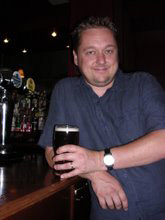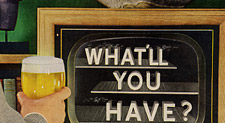 Author Pete Brown – who is having way too much fun in his role as “the second-best beer drinker in Britain!” – has talked Coors into letting him take a pin (small cask) of India Pale Ale from its White Shield brewery in Burton-on-Trent and transport it to India in much the same manner the highly hopped beer would have traveled in the 19th century.
Author Pete Brown – who is having way too much fun in his role as “the second-best beer drinker in Britain!” – has talked Coors into letting him take a pin (small cask) of India Pale Ale from its White Shield brewery in Burton-on-Trent and transport it to India in much the same manner the highly hopped beer would have traveled in the 19th century.
Not everybody would consider this the best beer holiday ever, but if you care about IPA and its history this might be better than a visit to Belgium or one to Bavaria. It’s a once-in-a-lifetime trip. You can go to Bamberg next year.
The Morning Advertiser provides the details (they wrote “pint” but must mean “pin”):
He’ll follow the route round the Cape of Good Hope, taken throughout the first part of the 19th century before the opening of the Suez Canal in 1869 shortened the journey.
Working with Coors brewer Steve Wellington, Pete will take to Bombay a pint of IPA brewed by Steve in Burton-on-Trent, Staffs, exactly as it would have been in 1820.
He sets off from Burton by canal in mid-October, spends a month on a P&O cruise ship, jumps on a 19th-century three-masted tall ship for the passage round the Cape, then spends a month on a giant container ship before arriving in India in late December.
Martyn Cornell provides more perspective:
“I’ve been saying for several years that a British brewer really ought to take a cask of well-hopped IPA and ship it to India to see what happens to the flavour – the Norwegians still do a similar thing with Linie Akvavit, though that goes to Australia and back, rather than the sub-continent.”
Which brings us to . . . an article in the new All About Beer magazine (dated September and with Dave Alexander on the front) titled “IPA Master Class.” From Roger Protz. But only half the story.
The cover touts the “Search for Authentic IPAs.” That means, I guess, that Stone IPA, Victory HopDevil and Bell’s Two-Hearted Ale aren’t authentic.
Te article provides important historical perspective about both IPA history (credit London before Burton-on-Trent) and the impact IPAs had on pale lagers. You need to read more, right?
I just wish that Protz, or AABM with a companion story, had got to American IPAs. A heck of a lot more drinkers consume US-brewed IPAs these days than those brewed in the UK. And these are beers that showcase Northwest hops.
Protz lists his personal Top Ten IPAs, with five from America:
– BridgePort IPA
– Brooklyn East India Pale Ale
– Goose Island IPA
– Sierra Nevada IPA
– Pike IPA
Great beers every one, but are they the first ones you think of when you say I’ll have an IPA?
But back to the top, the Morning Advertiser reports that Brown intends to write a travel book, rather than a beer book, about his journey. I can’t wait.
 Jack Curtin laments that he would have liked to have been in San Francisco this weekend for the celebration surrounding the Toronado’s 20th anniversary.
Jack Curtin laments that he would have liked to have been in San Francisco this weekend for the celebration surrounding the Toronado’s 20th anniversary. The authors of Mindless Eating: Why We Eat More Than We Think also have a little bit to say about mindless drinking – in this case wine. And it seems like the results of one study could be relevant to beer.
The authors of Mindless Eating: Why We Eat More Than We Think also have a little bit to say about mindless drinking – in this case wine. And it seems like the results of one study could be relevant to beer. Author Pete Brown – who is having way too much fun in his role as
Author Pete Brown – who is having way too much fun in his role as